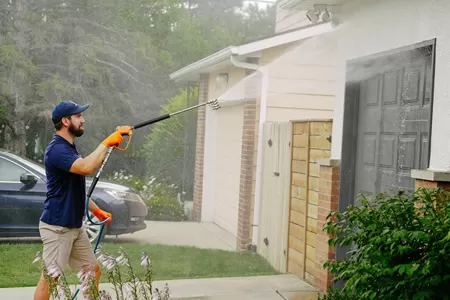Opening the Power of Stress Washing: An In-depth Look at Effective Outside Cleaning Solutions for Decks, Fences, and Walkways
Stress washing sticks out as an essential tool in outside upkeep, properly renewing decks, fencings, and pathways by eliminating built-up dirt, mold and mildew, and grime. The process not just improves the visual allure of your residential property yet also adds to its durability and safety and security. Attaining optimum results calls for an understanding of numerous techniques and tools tailored for various surface areas. As we discover the intricacies of pressure washing, it becomes noticeable that the right method can make a considerable difference-- yet numerous house owners ignore critical facets that can boost their cleansing efforts.
Advantages of Pressure Washing
Pressure cleaning properly rejuvenates surfaces, making it an important upkeep practice for both domestic and commercial properties. By eliminating dust, mold, mildew, and crud, pressure cleaning restores the original appearance of surface areas, adding to an extra inviting atmosphere.
In addition, pressure washing prolongs the life-span of surfaces. Routine cleansing can prevent the buildup of dangerous substances that result in damage, conserving homeowner significant expenses out of commission or replacements. Moreover, stress cleaning advertises health and safety by eliminating slippery compounds, such as algae or moss, which can present threats.
One more benefit is the effectiveness of the procedure. Stress cleaning can cover big locations in a fraction of the time it would certainly take utilizing standard cleansing techniques. This efficiency is particularly beneficial for industrial properties that require minimal disruption to procedures.
Preparing for Stress Laundering
Before participating in pressure cleaning, mindful prep work is important to make sure optimal results and safeguard surrounding locations. Begin by examining the area to be cleaned, getting rid of any kind of barriers such as furniture, planters, or decorative things. This produces a clear work area and minimizes the threat of damages during the cleaning procedure.
Next, evaluate the surface areas for any type of loose paint, mold, or debris. Dealing with these issues ahead of time can enhance the efficiency of the stress washing. Scratching off loose paint can stop it from being forced right into the surface throughout washing.
In addition, it is essential to secure close-by plants, windows, and delicate surface areas. Think about covering plants with tarpaulins or plastic bed linen and using painter's tape to protect windows from water damages (Soft Washing). Ensure that the stress washer is outfitted with the appropriate nozzle and pressure settings for the certain surfaces to prevent causing harm
Last but not least, prepare the pressure washer by inspecting fluid degrees and making sure all links are safe. This preparation prepares for a successful pressure washing session, generating a tidy and revitalized exterior.
Methods for Various Surfaces
Accomplishing optimum cleanliness requires a tailored technique to various surfaces during pressure washing. Each material, whether wood, concrete, or plastic, requires specific techniques to guarantee efficient cleansing without creating damages.
For wood decks, utilizing a low-pressure setting is crucial. This technique avoids splintering and protects the wood's stability. Using a cleaning service created for wood can improve the removal of crud and mildew, ensuring a thorough clean.
Concrete surface areas, on the various other hand, can endure greater pressure levels. A fan nozzle is advised for huge locations, while a slim nozzle can target challenging discolorations properly. Pre-treating discolorations with a degreaser can generate enhanced results, especially for oil or grease marks.
Vinyl fences call for a gentler touch, comparable to wood. A medium-pressure setting combined with a soft-bristle brush attachment can effectively get rid of dust without scraping the surface. It is vital to use a cleaning remedy especially developed for vinyl to avoid staining.
Selecting the Right Equipment
Picking the suitable tools is vital for effective pressure cleaning, as it directly affects efficiency and cleaning outcomes. The first factor to consider is the pressure washer itself, which can be found in various kinds: electrical, gas, and diesel. Electric models are excellent for light-duty jobs such as cleaning decks and fences, while gas-powered devices provide higher pressure and are matched for harder jobs like getting rid of gunk from walkways.
Following, think about the stress ranking measured in PSI (pounds per square inch) For delicate surface areas, a reduced PSI (1,500 - 2,000) is enough, while extra durable materials may need rankings of 3,000 PSI or even more. Additionally, the circulation rate, measured in GPM (gallons per minute), is essential; higher GPM suggests quicker cleaning.
Nozzles play a significant function in attaining preferred results, with various colors suggesting differing spray angles and stress. A revolving nozzle can improve cleansing performance on persistent discolorations. Last but not least, don't overlook important devices such as surface area cleansers for level surface areas and expansion wands for hard-to-reach areas. By meticulously picking visit tools customized to specific cleaning jobs, you can take full advantage of effectiveness and attain optimum lead to your stress washing ventures other - Soft Washing.

Upkeep Tips After Cleaning
Correct maintenance after stress washing is vital for extending the life-span of both the cleaned surface areas and the equipment made use of. After completing your stress cleaning job, allow the surface areas to dry totally to prevent wetness retention, which can lead to mold and mildew and mold development.
On a regular basis examine the cleansed areas for indications of dust accumulation or deterioration. Setting up periodic cleanings based upon ecological exposure can assist keep their appearance and honesty. For equipment maintenance, ensure that you completely clean up the stress washer after usage, getting rid of any debris from the nozzle and tubes. Additionally, inspect the oil degrees and change filters as needed to make sure optimal performance.
Store your stress cleaning devices in a completely dry, protected location to stop rust and damage. Concrete Cleaning. Adhering to these upkeep tips will certainly not just maintain your exterior rooms looking pristine but also take full advantage of the effectiveness and life expectancy of your pressure washing devices
Conclusion
